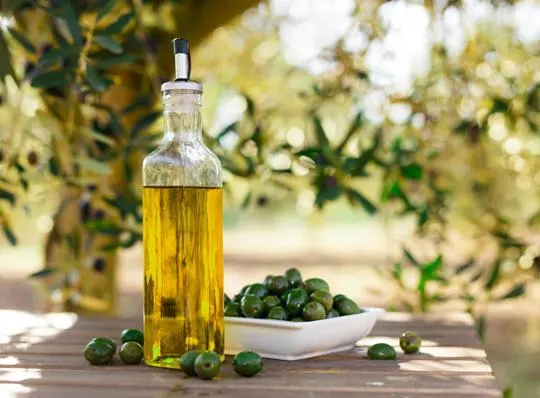Summary of key points
The main difference between Italian and Spanish olive oil is the type of olives used in production. Italian olive oil is typically made with Frantoio, Leccino, Pendolino or Moraiolo olives, while Spanish olive oil may use Arbequina, Hojiblanca or Picual olives.
In terms of flavor, Italian olive oil tends to have a more robust and peppery taste, while Spanish olive oil is known for its fruity and nutty flavors. Both are high-quality options and are often considered the best in the world.
It’s also worth noting that Italy and Spain have different regulations for their olive oils, with Italy having stricter standards for production and labeling. Regardless of preference, both Italian and Spanish olive oil add delicious flavor to dishes.
Olive oil: the liquid gold in our kitchens. We’ve all grabbed a bottle, pondering its secrets.
Italy and Spain, two giants in the game, offer up varieties as rich and complex as their histories.
Yet here we are, in the grocery aisle, scratching our heads.
What sets them apart?
I remember the first time I tried to make an authentic Italian pasta. The flavor? Off. The issue? My olive oil choice.
We learned the hard way, so you don’t have to. Spanish oil often boasts a fruity, nutty flavor.
Italian oil? Bold, peppery punches. Each transforms a dish in its own unique way.
Our kitchens have seen both triumphs and disasters, all in the name of finding the perfect oil.
Let’s break down this mystery together.
What is Italian Olive Oil?

Italian olive oil is an iconic, treasured culinary delight.
It’s famous for its quality, coming from olives native to the Mediterranean.
The ideal climate and soil, plus expert craftsmanship, make it special.
This tradition goes back centuries.
Italy follows strict rules for production.
Olives are handpicked at the right ripeness, then pressed for the liquid gold.
This meticulousness keeps the olives’ integrity, giving the oil a smooth and robust flavor.
The classification system is one of Italian olive oil’s features.
Quality and production methods decide the grade; extra virgin holds the top spot.
Virgin olive oil is also high quality, while refined olive oil has more processing to remove impurities.
There are health benefits too.
It has antioxidants and monounsaturated fats.
These can reduce inflammation, improve cardiovascular health, and promote wellbeing.
It’s also used in skincare for moisturizing.
Drizzled over bread or in sauces, Italian olive oil adds flavor.
From fruity to peppery notes, there’s something for every palate.
Enjoy the true taste of Italy’s liquid treasure.
What is Spanish Olive Oil?

Spanish olive oil is an exquisite liquid gold.
Spanning centuries of tradition and expertise, it’s renowned for its distinct flavors and aromas.
Produced from a variety of olives native to Spain, the production process is labor-intensive.
Olives are hand-picked at the peak of ripeness, then cold pressed to extract the oils.
Resulting in a smooth and well-balanced oil, it adds depth and character to dishes.
With a long history dating back to Roman times, Spanish olive oil is one of the best.
Spaniards take immense pride in their olive groves, which cover vast landscapes.
Mild Mediterranean climate and fertile soil enhance flavor profile.
One unique aspect of Spanish olive oil lies in its range of varieties.
From delicate and fruity Arbequina to robust and peppery Picual, each type adds its own characteristics.
This diversity allows for endless culinary possibilities, as different oils can complement specific dishes or enhance certain flavors.
Spanish olive oil is subject to strict production regulations.
To bear the label of “extra virgin,” only the highest-quality oils can be used.
This designation signifies the oil was extracted using mechanical methods without heat or chemicals.
Superior product with exceptional taste and health benefits.
In addition, Spanish olive oil is prized for its culinary merits and its health benefits.
Packed with antioxidants and monounsaturated fats, it supports heart health.
It also aids digestion and contributes to overall well-being.
Differences Between Italian and Spanish Olive Oil

Italian and Spanish olive oils differ.
Despite differences, both Italian and Spanish oils are prized globally for their taste and use in cooking.
Cultivation and Varieties
Italy and Spain, expert producers of olive oil, have different cultivation methods and varieties.
Italians use Leccino, Frantoio and Pendolino olives to create a robust and fruity flavor.
Spain, however, mainly uses Picual, Hojiblanca and Arbequina olives, which give a smooth and delicate taste.
These distinct varietals lead to their diverse olive oil flavors.
In Italy, labor-intensive practices guarantee top quality.
Pruning and harvesting are done by hand.
This attention to detail gives their olive oil an intense flavor, representing Italy’s heritage.
Spain, on the other hand, uses modern technology for planting and harvesting.
While this may reduce the traditional artistry of the process, it produces higher yields and consistent flavor.
Geography also affects cultivation.
Italy has a temperate climate with regular rainfall.
Regions of Spain have hot summers and sporadic rain.
These climate differences impact olive tree growth in each country.
Flavor Profiles
When it comes to olive oil, the flavors of Italian and Spanish varieties are distinct.
Each has its own unique qualities that make it different.
Italian olive oil often has a delicate and fruity flavor.
Spanish olive oil is known for its robust and peppery taste.
This difference in flavor can be due to factors like climate, soil, and olive varieties.
Italian olive oil has a smooth, buttery taste with sweetness.
This is because Italians harvest olives when they are unripe and green.
They also use cold-pressing to keep the flavors and aromas.
Spanish olive oil has a bold, intense flavor.
This is because Spanish olives ripen fully on the tree before being harvested.
Spanish producers also use modern extraction techniques like centrifuges and continuous systems.
This higher polyphenol content gives it a peppery or spicy finish.
Producers within each country can have different flavor profiles.
Regional differences, olive cultivars, and harvesting techniques all affect the taste.
Production Methods
Production techniques are essential for olive oil quality.
Italy and Spain have distinct methods, leading to different flavors and textures.
In Italy, hand-picking olives is valued.
Pressing is gentle, keeping natural aromas and flavors.
This gives Italian olive oil a smooth, fruity taste with grass notes.
In Spain, modern machinery is used for harvesting and processing.
It produces large amounts of oil, suitable for cooking or drizzling.
Spanish oil has a bold flavor, with hints of almond and pepper.
Both countries have strict regulations for quality.
The production methods create unique characteristics.
From hand-picking in Italy to machinery in Spain, each nation adds its own flair to the oil.
So when buying olive oil, decide which you prefer.
Italian or Spanish? You’ll get centuries-old techniques, for an amazing culinary experience.
Regional Influences on Taste
Italy and Spain make high-quality olive oil.
Each has unique tastes.
Italy’s olive oil is fruity and robust.
This is due to the type of olives, soil, climate, and harvesting techniques.
In Spain, many climates and terrains mean a varied range of flavors.
Cultivars vary and can be mild and buttery to peppery and pungent.
Factors like altitude, rainfall, and ocean proximity influence this.
Italy and Spain both produce great oils, but with regional differences.
Tuscany’s olives have grassy notes and herbal undertones.
Southern Spain’s Andalusian oils are bold and slightly bitter.
Similarities Between Italian and Spanish Olive Oil

Italian and Spanish olive oils share many features that make them stand out in cooking.
Both have unique flavors, making them “liquid gold”.
Production methods in both countries are traditional.
Olives are picked by hand at peak ripeness and cold pressed to extract the oil.
Frantoio, Leccino, and Moraiolo olives are used for Italian olive oil, giving it a fruity and peppery flavor.
Spanish olive oil is made from Picual, Arbequina, and Hojiblanca olives, making it milder.
Both olive oils have a high smoke point, suitable for frying, grilling, and sautéing.
They are full of monounsaturated fats and antioxidants that benefit heart health and fight inflammation.
Though similar, Italian and Spanish olive oils have nuances due to regional terroir and climate.
These differences affect the flavor notes in each country’s range of olive oils.
Culinary Uses and Pairings
Italian and Spanish olive oils provide distinct flavors to enhance dishes.
Italian olive oil is commonly used as a base for sauces, dressings, and marinades.
It adds a fruity flavor to pasta, grilled veggies, and roasted meats.
It can also be drizzled over salads or dipped with crusty bread.
Spanish olive oil has a more robust flavor.
It is used in paella, tapas, and gazpacho.
It complements chorizo, Manchego cheese, and cured ham and adds depth to soups, stews, and seafood dishes.
Italian olive oil is milder with hints of sweetness and grassiness.
Spanish olive oil has a stronger flavor with a peppery kick.
For pairings, both oils go well with Mediterranean ingredients like tomatoes, herbs, garlic, and citrus fruits.
Italian olive oil pairs with delicate dishes, while Spanish olive oil works with bolder ingredients like red meat and spicy foods.
Experiment with different combinations to find new depths of taste.
Store olive oil in a cool, dark place to maintain its freshness and quality.
Choosing Between Italian and Spanish Olive Oil
Choosing between Italian and Spanish olive oil can be a challenge.
Both countries produce amazing oils, each with unique characteristics.
Italy has a long history of olive cultivation, and its oils are known for their fruity flavors, balanced bitterness, and peppery finish.
On the other hand, Spain is the largest olive oil producer in the world.
It offers various types like Picual, Arbequina, and Hojiblanca, which are known for their robust flavors and notes of almond or tomato.
Italian olive oil has regional diversity.
Tuscan extra virgin oil is delicate, while Sicily and Puglia have stronger flavors.
Additionally, Italian olive oil is labeled according to production method – extra virgin being the highest quality.
Spanish olive oils also have regional diversity.
Andalusia’s hot temperatures result in oils with intense flavor profiles.
Meanwhile, Catalonia’s milder oils are good for everyday use.
Moreover, Spanish olive oils undergo rigorous quality control.
It’s all about personal preference.
Some may prefer the mildness of Italian oils, while others enjoy the boldness of Spanish oils.
It’s great for drizzling over salads, bread, cooking, or dipping with full-bodied dishes.
Quality and Labeling Standards
When it comes to olive oil, quality and labeling play a key role in distinguishing Italian and Spanish varieties.
Both countries have rules to ensure consumers get the best product.
Italian oil is famous for its quality.
It is made from various olives, such as Frantoio, Leccino, and Pendolino.
The production process is very strict to maintain the oil’s purity and authenticity.
It has a balanced flavor with fruity and grassy notes, perfect for salads or bread.
Meanwhile, Spain’s olive oil tradition goes back centuries.
They have regulations to guarantee top-notch quality.
Spanish oils are often made from a single type of olive like Arbequina or Picual, giving them their own flavor.
They can be used in cooking because of their robust taste and higher smoke point.
Both Italy and Spain have labeling standards to show the origin and quality of the oil.
Labels may include the type of olives, the extraction method, and certifications.
Conclusion
All in all, the differences between Italian and Spanish olive oil can be murky if you’re not an olive oil aficionado, but it’s worth it to try both kinds to see which one fits your tastes better.
Additionally, olive oils vary from region to region and even within regions; in other words, there’s a lot of diversity as far as Italian or Spanish olives are concerned.
Be sure to read up on the label before making a purchase – no two bottles of olive oil are ever alike.
Don’t forget to consider how you’ll use the oil when picking out your bottle; if you’re going for a subtle flavor that won’t overpower any dishes, then Spanish might be best.
On the other hand, if you plan on using it mainly for cooking and want more flavor intensity then Italian might be for you.
Finally, some people argue that their choice between Italian and Spanish lies in price – since each country offers different pricing options based on quality and region.
No matter which one you choose for yourself, both varieties offer health benefits that make them worth trying.

Leave a comment